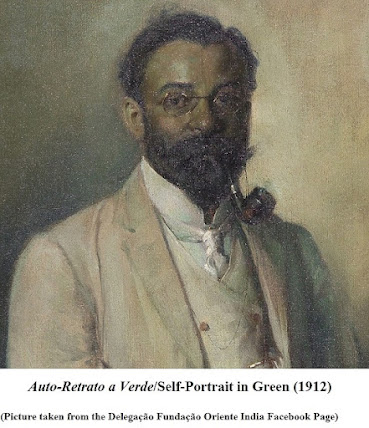AX Trindade and His Artistic Legacy to Goa
António Xavier Trindade is indeed an exemplary Goan talent; one that has been showcased at the Fundaҫão Oriente-India. The Trindade Collection was donated to the Fundaҫão Oriente in 2004 by the Esther Trindade Trust. The collection has works of both, António Xavier Trindade and Angela Trindade (1909-1980), his daughter and noteworthy artist in her own right.
Trindade was born
in 1870 in Sanguem, Goa to Roman Catholic parents and went on you seek an
education in art at the renowned Sir Jamsetjee Jejeebhoy School of Art in
Bombay (Mumbai) at the age of 17. He then became part of the faculty in 1921
after the completion of his studies, earning a reputation as one of India’s
leading artists who was well-appreciated in both Western and Indian circles.
Considered a realist, Trindade would nevertheless continue to incorporate elements of the Romantic era. His technique of light and dark is similar to work by Spanish artists Diego Velázquez (Baroque) and Francisco Goya (Romanticism). His Western upbringing and education is prominently reflected in his art; but while his much appreciated style and skill were deeply entrenched in the principles of Western art, his concentration was Indian themed subjects. Trindade’s art is, consequently, a brilliant example of the merging of the East and the West, capturing adroitly Indian people and landscapes with equal expertise on watercolour as well as oil paintings.
A much sought
after portrait painter, Trindade’s genius was esteemed in his lifetime as is
evinced by the frequent presence of his paintings at the Bombay Art Society’s
exhibitions. His Dolce Farniente/Sweet
Tranquillity (1920) won him the Bombay Art Society’s gold medal, which was a
formal and well-deserved acknowledgement of the man’s artistic prowess. Trindade’s
artistic ability is enshrined in permanent exhibitions in India’s most famous
museums, as in the Prince of Wales Museum of Western India (now called the Chhatrapati
Shivaji Maharaj Vastu Sangrahalaya) in Mumbai.
Trindade’s oeuvre includes his family and himself as subjects. Examples that stand out are Auto-Retrato a Verde/Self-Portrait in Green (1912), A Familia do Artista à Luz do Candeeiro/The Artist’s Family by Lamplight (1916), Dolce Farniente, which has his wife as his model and Retrato de Esther Reclinada/Portrait of Esther Reclining (n.d.), which is a portrayal of his daughter Esther. Dr Annie Besant and Lady Meherbai Tata, who belonged to the famous industrial family of the Tatas, were among the well-known personalities that Trinidade immortalised with his exquisite brush strokes. His artistry is entrenched in his masterful rendering of more of the character of his model with less of the stylistic embellishments that were utilised by French and British orientalists.
Apart from his
portraits of the rich and famous, Trindade is noted for his depictions of
ordinary people as in Sanyasi (n.d.),
a portrait of a fakir, and in Mendigo
Goês/Goan Beggar (1927). Mulher com
Sari Azul e uma Vasilha/Woman with a Blue Sari with Pot (1927), Cena de Nasik com Banhistas/Scene of
Nasik with Bathers (1932) and Cena de
Nasik com Templos/ Scene of Nasik with Temples (1932) are excellent
representations of Indian cultural and religious ethos. Landscape paintings
that capture the essence of the environs of Bombay and Goa are Vista de Terraҫo em Mahim/View from the
Terrace in Mahim (1930) and Barcos e
Pesca Goeses/Goan Fishing Boats (1930). Apart from landscapes and
portraits, Trindade was exceptionally skilled at still life paintings.
This ‘Rembrandt of
the East’, as Trindade has been rightly titled, left for his final abode on the
16th of March 1935. His artistic legacy, however, lives on and is
accessible at the Fundaҫão Oriente Art Gallery, Monday to Saturday from 10am to
6pm.
Address: 175,
Felipe Neri Road,
Fontainhas (Behind
People’s High School),
Panjim,
Goa-403001,
India.
Phone: 08322230728
Email: foriente@dataone.in
Facebook Page
@forienteindia






Comments
Post a Comment